 Checking out the “ingredients” of a product —whether food or object— can yield a lot of information about how the thing is made, and inspire ideas for riffs and innovation on the theme.
Checking out the “ingredients” of a product —whether food or object— can yield a lot of information about how the thing is made, and inspire ideas for riffs and innovation on the theme.
While shopping for pair of boots online, I stumbled on a pair by designer Martin Margiela made of “waxed suede”. Waxed suede? I wondered what it looked like and if waxing might be a solution to suede that had become lousy-looking from use. So I ordered the boots to check them out. The boots had a slightly rough but definitely cool, sophisticated patina. It would be GREAT to be able to transform worn suede products into that. I decided to try waxing some suede myself to see what would happen, and if I could achieve an interesting effect myself. First question: what to use, since I had no suede scraps lying around? The unseen “inside” side of an old suede belt would allow me to still wear the belt without anyone seeing my experiments, so the belt would be my test material. Next: what kind of wax to use? Having recently done a post on waxing cotton, I tried Otter Wax, rubbing the block into the belt to make a rectangle.

The wax lumped a bit so I tried rubbing it in with my finger (ouch!). Then I used a hair dryer to melt the wax and soak it into the suede. After it cooled and set for a half hour or so, I buffed it, first with a cloth, and then with a toothbrush. The effect interesting, though way more mottled than the Margiela boot. Then it dawned on me to try Briwax, furniture paste wax I’ve been using for years to clean and restore vintage furniture. It’s a mix of beeswax and solvents so it is not as environmentally friendly as Otter Wax, nor something you want to wear next to your skin. But I thought it would be fine for the outside of boots and shoes.
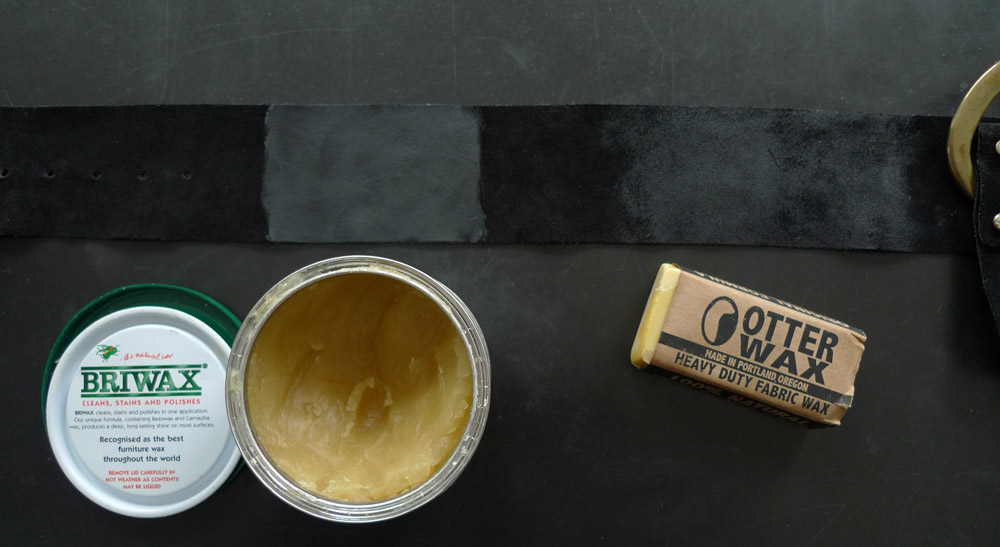
The Briwax soaked right into the suede leaving an opaque coating. As I do when waxing furniture, I let it set for a half hour or so. Then I tried buffing it, first with a rag, then with an soft toothbrush.
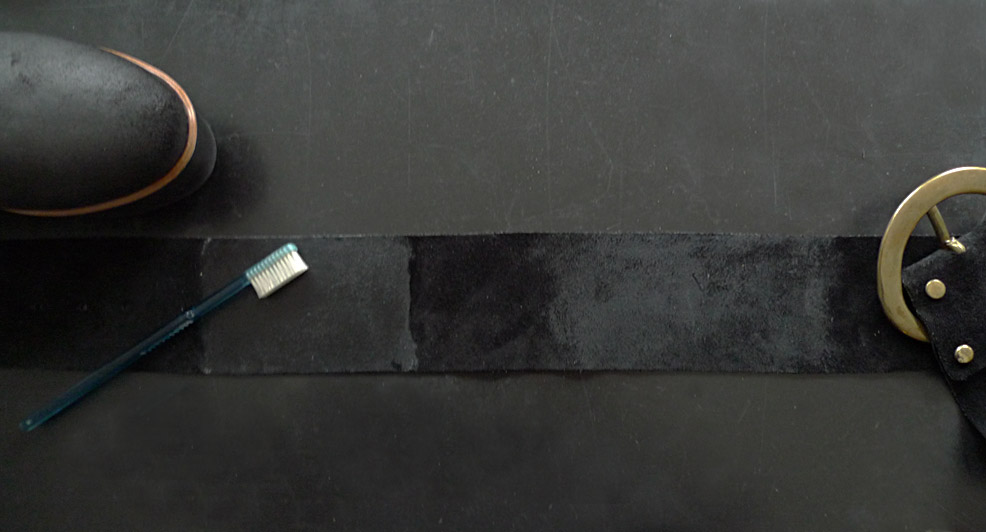
Briwax buffed to a fine slightly shiny coating, very similar to that of the Margiela boots. In the photos directly above and below, you can see how the two waxes coated the suede: Briwax is on the left, Otter Wax on the right.
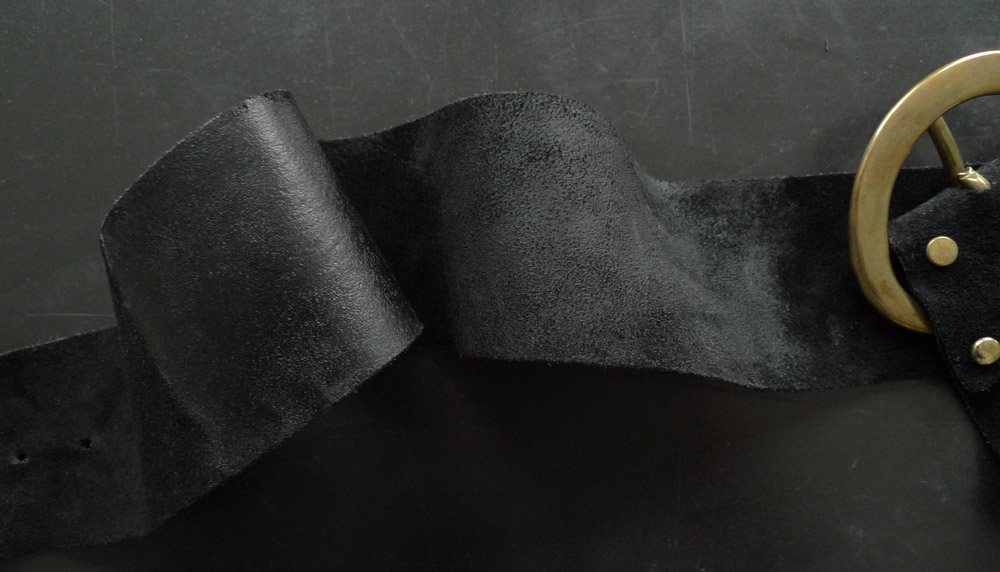
A day later, any trace of Briwax’s solvent smell was gone, and the surface seemed tightly sealed, so it might just be fine using on a suede bag. It’s very possible other waxes would work as well, and would be worth a test. What look you prefer is up to you. For me, Briwax is an immediate winner. Having stayed away from suede because it degrades so easily, knowing I can wax it has liberated my thinking about it, and its possibilities. Related posts: how to wax cotton…jackets, jeans, anything! resources for fixers ‘the furniture doctor’ and other hot tips for second-hand andrea zittel’s investigative livin
EDITOR’S NOTE: Years after publishing this post, when I looked into possible toxic additives via a page on Briwax’s site of links to data sheets for various products, I saw that they used a lot of dicey ingredients. I recommend experimenting with other beeswax based products that don’t have any solvents. Otter Wax is one I tried in the article but I found it quite hard to work with. Since the article was published, I see they’ve come up with a meltable heat-activated fabric dressing. What you want it the effect of Briwax: creamy and spreadable that dries to a nonsticky finish. This one looks also looks promising The thing to do would be to try the products on patches of suede on a part of your item that doesn’t show. OR just buy piece of similar suede to do your experiments.

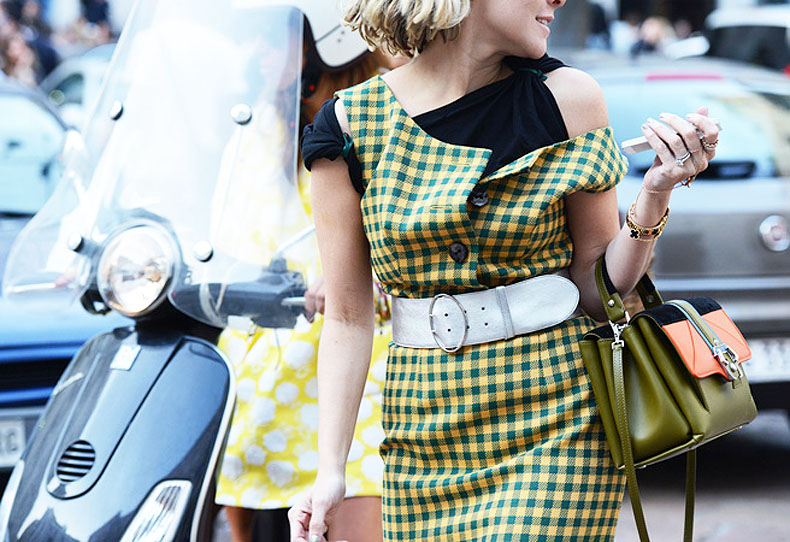

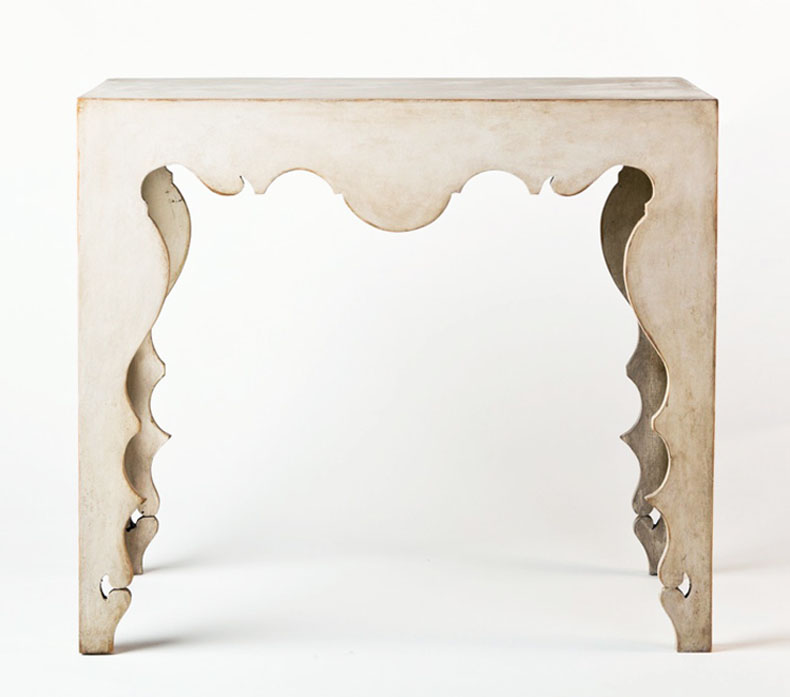
I put some mink oil on my brown suede boots a few years ago to help repel water, they came out with a finish similar to what you are looking for,
An intriguing post! I got some bags for my shop from the Netherlands recently that were “Greased” suede and I immediately recognized it in the Margiela boots in your post. It’s really a beautiful effect.
I did some digging online, and an old post at the Style Forum linked to this article, which recommends using Sno-Seal: http://www.90thidpg.us/Equipment/Projects/Dubbing/index.html
It looks like Sno-Seal is a beeswax-based product without the solvents, so it might be a good substitute for Briwax.
I generally avoid suede because I live in a rainy climate (Pac NW) but this might be the solution!
Oh, I forgot to link to the Style Forum post: http://www.styleforum.net/t/66428/do-it-yourself-waxed-suede
GREAT. So so far other options we have are Sno-Seal and Mink Oil. I love it. Lots of possibilities.
Hey Sally, love your work. I’m planning to do exactly that for a leather jacket (black suede roughout), but I wonder if the jacket is not going to lose its supple texture, and become rigid like some cardboard, what is your experience with that and the BRIWAX, please?
Thanks a lot for everything,
The jacket should retain its supple feel though the surface won’t be that soft suede handfeel. I found Briwax gives the best finish. If you have any patches that don’t show, say on the inside, you could always do a test of another wax. (Or on a similar piece of suede.)
Thank you so much for the quick reply, last question is about the health hazard linked to wearing a jacket that is fully covered with Briwax, would you say that the toxic chemicals will be gone after drying up? I checked the Briwax cmposition and it seems a bit hazardous? I would just try to avoid exposing my skin too much, also there is a thin liner in between the leather and my skin…?
Hmmm. Good question. I don’t know for sure about that. I just found a page on Briwax’s site of links to data sheets for various products. I notice they list a Toluene Free Briwax, so I assume Toluene is a dicey ingredient. But it still doesn’t look great. I would experiment with some beeswax based products that don’t have any solvents. Otter Wax is one I tried in the article but I found it quite hard to work with. Since the article was published, I see they’ve come up with a meltable heat-activated fabric dressing. What you want it the effect of Briwax: creamy and spreadable that dries to a nonstick finish. This one looks also looks promising The think to do would be to try the products on patches of suede INSIDE the jacket that doesn’t show. OR just buy piece of similar suede to do your experiments. Please let me know what you figure out.